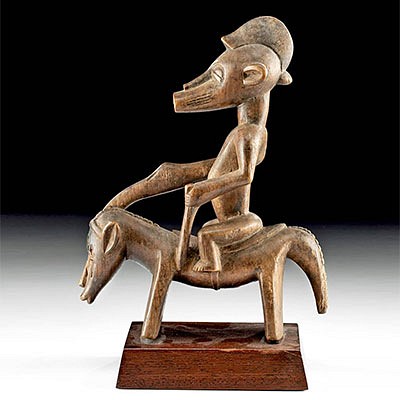Nayarit Chinesco Type B Bichrome Seated Figural Vessel
Lot 153
About Seller
Artemis Gallery
686 S Taylor Ave, Ste 106
Louisville, CO 80027
United States
Selling antiquities, ancient and ethnographic art online since 1993, Artemis Gallery specializes in Classical Antiquities (Egyptian, Greek, Roman, Near Eastern), Asian, Pre-Columbian, African / Tribal / Oceanographic art. Our extensive inventory includes pottery, stone, metal, wood, glass and textil...Read more
Categories
Estimate:
$1,400 - $2,100
Absentee vs Live bid
Two ways to bid:
- Leave a max absentee bid and the platform will bid on your behalf up to your maximum bid during the live auction.
- Bid live during the auction and your bids will be submitted real-time to the auctioneer.
Bid Increments
| Price | Bid Increment |
|---|---|
| $0 | $25 |
| $300 | $50 |
| $1,000 | $100 |
| $2,000 | $250 |
| $5,000 | $500 |
| $10,000 | $1,000 |
| $20,000 | $2,500 |
| $50,000 | $5,000 |
| $100,000 | $10,000 |
| $200,000 | $20,000 |
About Auction
By Artemis Gallery
Feb 17, 2022
Set Reminder
2022-02-17 10:00:00
2022-02-17 10:00:00
America/New_York
Bidsquare
Bidsquare : CLEARANCE | Ancient & Ethnographic Art
https://www.bidsquare.com/auctions/artemis-gallery/clearance-ancient-ethnographic-art-8898
Join us for our first clearance sale of the year featuring discounted pricing and many new items! Asian art, Classical antiquities from Egypt, Greece, Italy, and the Near East...plus Pre-Columbian, Tribal, Spanish Colonial, Fine Art, Fossils, more! Artemis Gallery info@artemisgallery.com
Join us for our first clearance sale of the year featuring discounted pricing and many new items! Asian art, Classical antiquities from Egypt, Greece, Italy, and the Near East...plus Pre-Columbian, Tribal, Spanish Colonial, Fine Art, Fossils, more! Artemis Gallery info@artemisgallery.com
- Lot Description
**Originally Listed At $900**
Pre-Columbian, West Mexico, Nayarit, Chinesco, Type B, Protoclassic Period, ca. 100 BCE to 250 CE. A wonderful example of a hand-built pottery Chinesco Type B figural vessel resting atop legs folded beneath thick thighs. Highly burnished and decorated with cream pigment atop a brick-red ground, the figure presents with a painted, stippled waist band while holding sinuous arms atop the relatively flat abdomen. A pair of petite, perky breasts protrude from just beneath the shoulders which are themselves dramatically hunched, and the thick neck tapers slightly to form the enlarged, heart-shaped head. The countenance is comprised of raised, coffee-bean eyes, a petite nose adorned with a nose ring, a narrow mouth, and perky ears, all beneath a peaked, incised coiffure with an openwork spout opening. Size: 6.5" W x 9.3" H (16.5 cm x 23.6 cm)
Provenance: private Healy collection, Studio City, California, USA, acquired May 2020; ex-Arte Primitivo, New York, New York, USA (May 29, 2020, lot 86); ex-collection of Richard Gregory (financial analyst for Hearst Magazines), 1980s, to current owner by inheritance
All items legal to buy/sell under U.S. Statute covering cultural patrimony Code 2600, CHAPTER 14, and are guaranteed to be as described or your money back.
A Certificate of Authenticity will accompany all winning bids.
PLEASE NOTE: Due to recent increases of shipments being seized by Australian & German customs (even for items with pre-UNESCO provenance), we will no longer ship most antiquities and ancient Chinese art to Australia & Germany. For categories of items that are acceptable to ship to Australia or Germany, please contact us directly or work with your local customs brokerage firm.
Display stands not described as included/custom in the item description are for photography purposes only and will not be included with the item upon shipping.
#166552Professionally repaired and restored from multiple pieces, with restoration across head, body, and base, and resurfacing with overpainting along new material and break lines that is nearly invisible. Abrasions and fading to areas of original pigment, nicks to face and base, and light encrustations within interior cavity. Nice remains of original pigment throughout. Old inventory labels beneath base.Condition
- Shipping Info
-
All shipping is handled in-house for your convenience. Your invoice from Artemis Gallery will include shipping calculation instructions. If in doubt, please inquire BEFORE bidding for estimated shipping costs for individual items.
-
- Buyer's Premium



 EUR
EUR CAD
CAD AUD
AUD GBP
GBP MXN
MXN HKD
HKD CNY
CNY MYR
MYR SEK
SEK SGD
SGD CHF
CHF THB
THB














